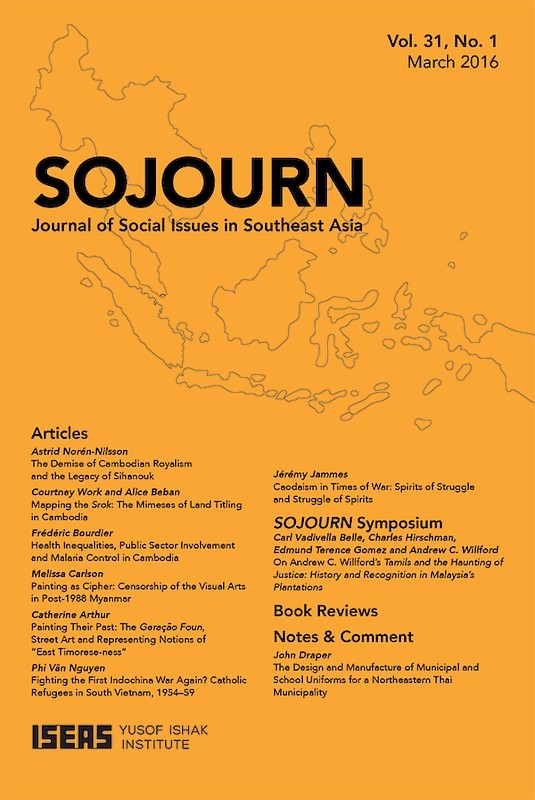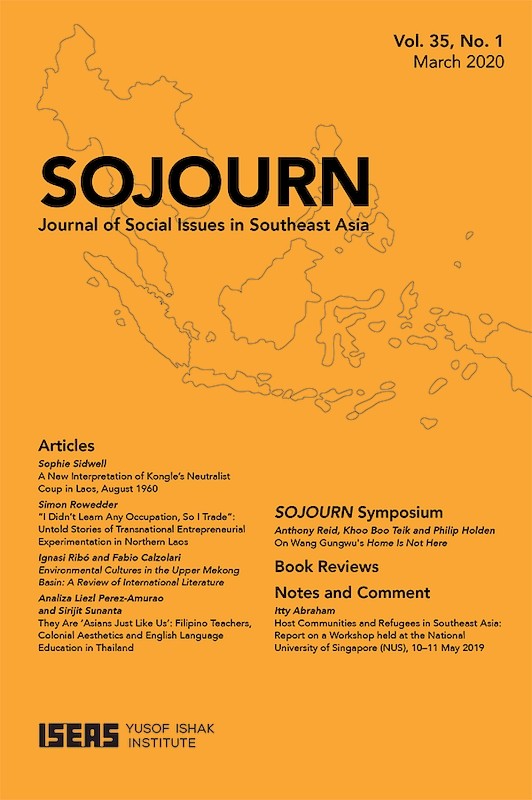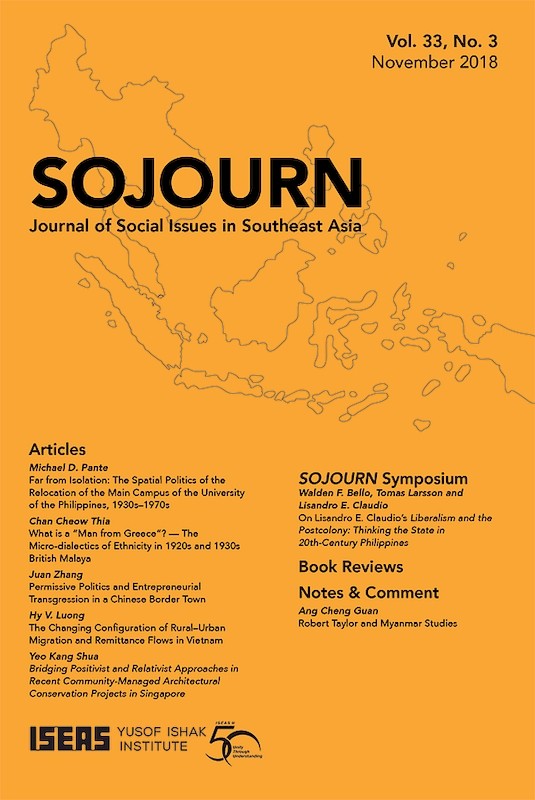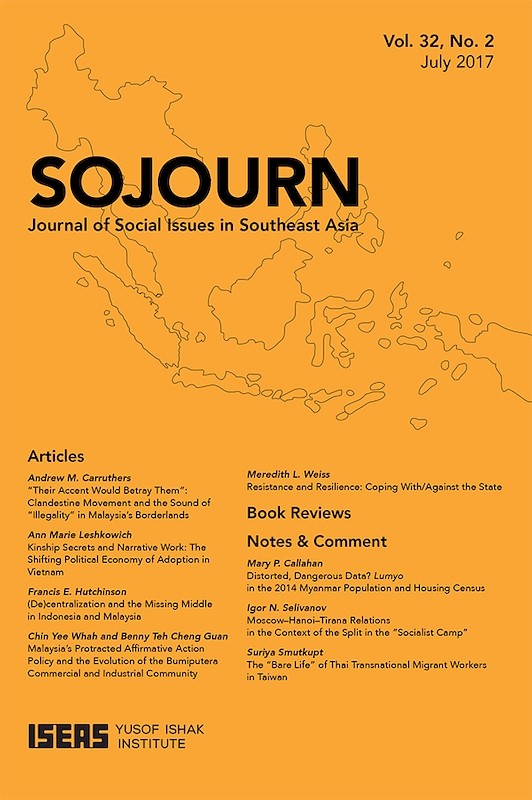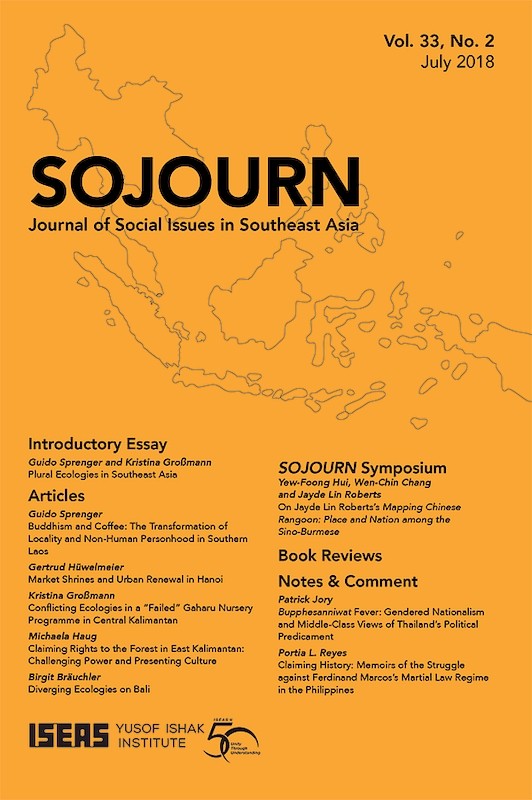SOJOURN: Journal of Social Issues in Southeast Asia Vol. 32/1 (March 2017)
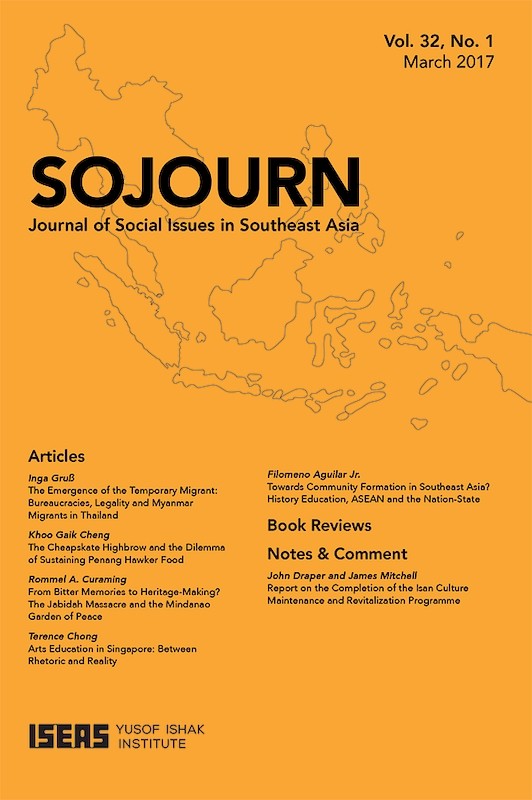
Michael J Montesano, editor
Date of publication:
March 2017
Publisher:
ISEAS – Yusof Ishak Institute
Number of pages:
220
Code:
SJ32/1
Contents
-
SOJOURN: Journal of Social Issues in Southeast Asia Vol. 32/1 (March 2017)
[Whole Publication, ISSN: 17932858] -
Preliminary pages
- ARTICLES
-
The Emergence of the Temporary Migrant: Bureaucracies, Legality and Myanmar Migrants in Thailand, by Inga Gruß, author see abstractThe national verification process that has provided formalized guidelines to regulate the migration of Myanmar workers to Thailand permanently places migrants in a zone of temporary legality. This zone is a bureaucratic space in which legality surfaces as a flexible concept serving the interests of the Thai and Myanmar states while placing an economic burden on migrants. Legality also emerges as a commodity that does not relate to migrants' compliance with the law, but rather to their ability to mobilize resources. Brokers not only guide migrants in navigating the transnational bureaucracies, but also mediate the emotional ties between migrants and those bureaucracies. The emotional undercurrents of the process ultimately serve as a reminder that any bureaucratic space is inherently affective.
-
The Cheapskate Highbrow and the Dilemma of Sustaining Penang Hawker Food, by Khoo Gaik Cheng, author see abstractIn 2014, the Penang Chief Minister imposed a ban on foreigners working as the main cooks of hawker food, in the attempt to preserve "local taste". Exploration of the dilemma of sustaining the taste of Penang hawker food and the profession of preparing it argues for a broader definition of "Penang hawker food". This definition acknowledges the confluence of Penang's migrant histories while being inclusive and reflective of changes in sociocultural trends, population and migration flows.
-
From Bitter Memories to Heritage-Making? The Jabidah Massacre and the Mindanao Garden of Peace, by Rommel A Curaming, author see abstractThe Mindanao Garden of Peace is a memorial to the victims of a tragic event, the 1968 Jabidah Massacre. It is widely believed in the Philippines that this episode sparked the still unresolved violent conflict in Mindanao. The recent establishment of the peace garden represents a major shift in the tenor of remembrance of the massacre, from being fiercely fractious to something rather tamed, domesticated and aestheticized. This shift reflected the optimistic collective views of the administration of President Benigno Aquino III, Muslim rebels and civil society organizations about the prospects for peace in Mindanao. Following the election of a new president, those prospects have become uncertain, and the direction of the ongoing process of remembering is in question. This development highlights the open-endedness of the heritage-making process.
-
Arts Education in Singapore: Between Rhetoric and Reality, by Terence Chong, author see abstractStudy of the trajectory of arts education in Singapore through examination of key policies and government reports suggests that, although the arts and arts education have generally taken a back seat to other national priorities, the government has consistently utilized them for ideological and political purposes. Arts education is typically subjected to the bureaucratic imagination, which assigns to arts education a particular state-sanctioned role. Whether to ennoble students as citizens of a newly independent nation or to endow them with the innovativeness believed to be necessary to a knowledge-based economy, arts education in Singapore has often shouldered the sociocultural aspirations of the ruling elite. This has been true even if the subject has not always been the recipient of unwavering political support.
-
Towards Community Formation in Southeast Asia? History Education, ASEAN and the Nation-State, by Filomeno V Aguilar Jr, author see abstractIn 2003 the Association of Southeast Asian Nations declared the establishment of an ASEAN Community. The teaching of regional history is seen as indispensable to the attainment of this goal. Eight country reports commissioned by UNESCO Bangkok in 2013 serve as the basis of an inquiry into history education and the teaching of Southeast Asian history in primary and secondary schools. State control of education has produced school systems that, despite their potential, hamper the imagining of a regional community. Under state directives, schools prioritize political socialization into the nation-state and sacrifice shared regional history in favour of national history. Yet promoting interest in national and Southeast Asian histories is possible.
- BOOK REVIEWS
-
BOOK REVIEW: Asia, Modernity, and the Pursuit of the Sacred: Gnostics, Scholars, Mystics, and Reformers, by Joel S. Kahn, by Brooke Schedneck, author
-
BOOK REVIEW: Indonesia's Changing Political Economy: Governing the Roads, by Jamie S. Davison , by Andrew M. Carruthers, author
-
BOOK REVIEW: Luk Thung: The Culture and Politics of Thailand's Most Popular Music, by James Leonard Mitchell, by Craig A Lockard, author
-
BOOK REVIEW: Living Buddhism: Mind, Self, and Emotion in a Thai Community, by Julia Cassaniti, by Barend Jan Terwiel , author
-
BOOK REVIEW: Beyond Borders: Stories of Yunnanese Chinese Migrants of Burma, by Wen-Chin Chang, by Hui Yew-Foong, author
-
BOOK REVIEW: Changes in Rice Farming in the Philippines: Insights from Five Decades of a Household-Level Survey, by Piedad Moya, Kei Kajisa, Randolph Barker, Samarendu Mohanty, Fe Gascon, and Mary Rose San Valentine, by Michael J Montesano, author
-
BOOK REVIEW: Ancient China and the Yue: Perceptions and Identities on the Southern Frontier, c.400 BCE–50 CE, by Erica Fox Brindley, by William Meacham, author
-
BOOK REVIEW: Dealing in Desire: Asian Ascendancy, Western Decline, and the Hidden Currencies of Global Sex Work, by Kimberley Kay Hoang, by Jayne S Werner, author
- NOTES & COMMENT
-
Report on the Completion of the Isan Culture Maintenance and Revitalization Programme , by John Draper, Mitchell Tan, authors see abstractThe Isan Culture Maintenance and Revitalization Programme was a four-year, 500,000- euro programme devised and implemented by four municipalities in Khon Kaen Province together with the College of Local Administration of Khon Kaen University in Northeast Thailand. The programme pursued five different action lines, with Ban Phai Municipality being responsible for traditionally made ethnic uniforms, Chum Phae Municipality for designing and installing multilingual signage, Khon Kaen Municipality for implementing the teaching of the Isan language as a subject in municipal schools, and Mueang Phon Municipality responsible for a multimedia collection of cultural performances. In effect, the programme piloted each of these four action lines in a given municipality and then sought to introduce each into the other three municipalities. The College of Local Administration was responsible for project coordination, research and visibility. The latter mainly took the forms of academic papers, research articles and newspaper columns. The principal results and outcomes of the programme included the first municipal multilingual Thai–Isan–English road signage in Northeast Thailand, the first Thai–Isan–English dictionary using a heritage script, the first Isan subject curriculum, a unique archive of Isan cultural performances, and the production of ethnic municipal and school uniforms.

